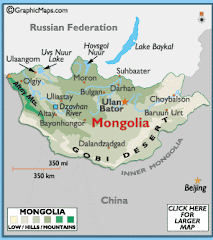We had one final trip to make before we started teaching English again. We traveled to Murun, the capital of Huvsgul Province. Two missionaries being transferred there traveled with us. Below is the Murun airport.
Murun is in the northern part of Mongolia, near Russia. It has mountains with pine trees nearby.
Here is our church building--a small room added to the front of an apartment building. Inside some of the rooms were probably once apartments. People live in the apartments upstairs and around the church.
There were lots of beautiful flowers in Murun.
Once again we went to see the hospital. This hospital is remodeling their top floor--where all the surgery is done. So right now they are using a private hospital's surgery room. When they are finished they will have two operating rooms. Clair is here with the missionary who translated for us. We loved Elder Telmen. He worked very hard to translate for us in spite of a hearing loss (he has two hearing aids), a speech impediment, and not feeling capable of translating. He used his dictionary a lot to look up medical terms. We were touched by his sweet spirit and desire to serve. We all worked hard when trying to help members with their medical problems.
These are the missionaries in Murun. We had lunch with them in a restaurant one day.
We visited a couple of homes of members. In both homes there were people with very severe health problems. One home had a cerebral palsy child, a father in heart failure, and a daughter who had been hit by a car that day. There was very little we could do for them. We did give a priesthood blessing to this sister.
The little child on the right was very friendly. He (or she) kept coming up to us and saying, "Sain-bain-oo," (which means, "Hello, how are you") and putting his hand out to shake ours. When children are little they often dress boys in girls clothes and leave their hair long. This comes from an old superstition that evil spirits were after boys, so they would disguise them. Now they have a custom of having a hair cutting time when they are 3 or 4. After that the boys look like boys. Sometimes they completely shave the children's heads (even the girls) at the hair cutting ceremony.
Here are some yaks we passed traveling through the countryside. We saw many yaks in this part of Mongolia. We also saw a few camels and lots of horses, sheep, goats, and cows. They Mongolians often live off their animals and milk all of them and use every part of them for something.
Here is beautiful Lake Huvsgul. We were able to spend a day visiting this beautiful lake known for its beauty and good fishing. The water was very clear and the boatmen drank straight from the lake. It is 264 meters deep.
We stopped on a shore and found a couple of kinds of edible wild berries. Above is Clair, below is Annette by the lake.
By the lake we met a couple who was raising some baby deer. They were very tame and fun to see.
Our boat drivers saw a fish by the shore when we landed. While we were looking at the deer they got two long poles and two nails. From them they made a spear and a fish hook on a pole.
One man attacked the fish from the top with the spear while the other attacked him from the bottom with the hook, and they caught the fish.
Here it is. They took it home for dinner! We had fish from the lake for lunch the day before and it was very good.
After the boat ride we took a horse ride by the lake, up a mountain, and around it, then back to the lake.
At the top of the small mountain was an "o-woo". We see these piles of rocks with sticks in them all over Mongolia. People tie pieces of blue silk on them. Sometimes the silk is other colors. Sometimes people leave money, or crutches, or other offerings. Usually people add a rock and circle the pile three times. It is a place of worship and also a place that signifies good luck to the travelers.
A herder on horseback out with his flock. A common sight in Mongolia. It was fun to see this beautiful part of Mongolia. Mongolians love their country and love their Mongolian traditional foods and other traditions. We feel privileged to have been able to learn about their culture and traditions. We love the Mongolians!
































